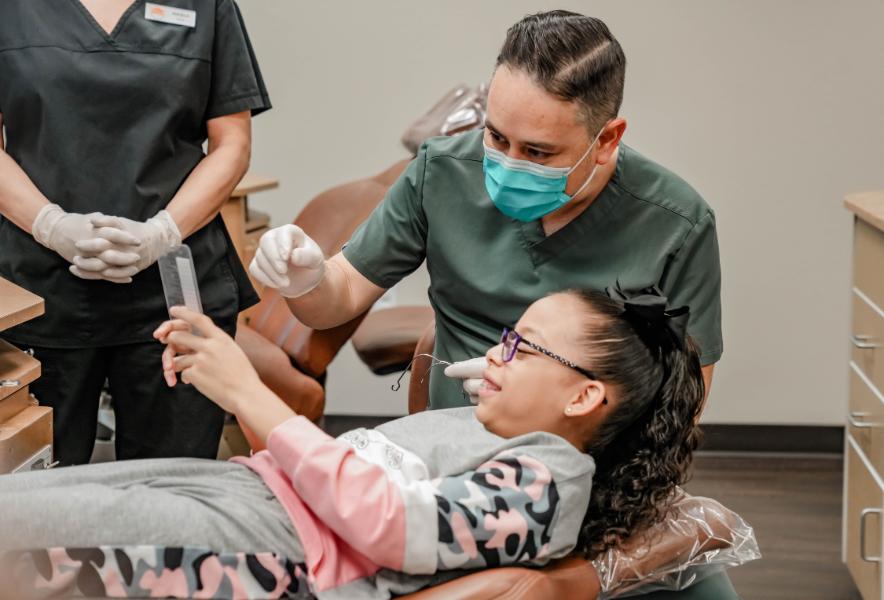By Dr. Mathue Faulkner | Rise + Smile Orthodontics | South Austin, TX
At Rise + Smile Orthodontics, I spend a lot of time talking about breathing—and not just because I love what I do (though I do). Airway health plays a huge role in orthodontic care, and I’ve seen firsthand how it can impact everything from how a child grows to how well they sleep at night.
This topic is personal for me, both as an orthodontist and as a dad of two daughters, ages 8 and 10. When I evaluate my patients—many of whom come from neighborhoods like Circle C, Oak Hill, Buda, Shady Hollow, and Dripping Springs—I’m not just looking at teeth. I’m thinking about how their airway is developing and how we can support better breathing now and into adulthood.
So, what does an airway-focused approach mean? And why should it matter to you and your family? Let’s dive into it.
A New Direction in Orthodontics (and Medicine)
Over the past several years, the medical and dental communities have started to change how they think about breathing. For a long time, airway issues were treated as an afterthought or shuffled between specialties—ENTs, sleep doctors, dentists—but no one really took ownership of them.
That’s changing.
Today, there’s a growing recognition that airway health is a shared responsibility. Pediatricians, ENTs, speech therapists, oral surgeons, myofunctional therapists, and yes—orthodontists like me—are teaming up to address breathing problems early and comprehensively.
At Rise + Smile Orthodontics, I work directly with local ENTs and a trusted myofunctional therapist to help diagnose and manage airway-related issues. I’ve learned that many of these concerns don’t require invasive testing to identify. In fact, they often show up in a child’s day-to-day symptoms—snoring, restless sleep, mouth breathing, bedwetting, behavior struggles, and more.
Airway 101: What You Should Know
Let’s talk structure. The airway is made up of two main sections:
- Nasal Airway: the passage through the nose
- Pharyngeal Airway: the passage through the throat into the lungs
These parts are deeply connected. If nasal breathing is blocked or restricted, the body naturally compensates by switching to mouth breathing. That might not sound like a big deal—but it really is, especially over time.
Here’s a neat anatomical fact: the roof of the mouth is also the floor of the nose. Think of a two-story house: the ceiling of the first floor is also the floor of the second. So, when we use orthodontic tools to widen the upper jaw (which we often do in growing kids), we’re also opening up space for a wider nasal airway. That means better breathing—not just a prettier smile.
Why Sleep Changes the Game
Breathing issues aren’t always obvious when a child is awake. The real trouble often shows up during sleep.
When we sleep:
- Our muscles relax (including the tongue and throat muscles)
- Gravity pulls everything downward
- The airway becomes narrower and more prone to collapse
If the airway becomes partially blocked, it can result in snoring—or worse, pauses in breathing (called apneas). Even if your child isn’t diagnosed with sleep apnea, snoring is never normal. It means the airway is struggling. And when that happens, oxygen levels can drop, disrupting deep, restorative sleep.
At Rise + Smile, I always ask about sleep quality because it gives me huge insight into how the airway is functioning. If a child can breathe well while sleeping—when the airway is at its most vulnerable—chances are they’re doing okay during the day too.

Nasal vs. Mouth Breathing: Why It Matters
Most people don’t think twice about how they breathe—but it matters. A lot.
While the mouth can be used to breathe when needed, nasal breathing is how our bodies are designed to function best. Here’s why it’s the gold standard:
- Tongue posture: When breathing through the nose, the tongue naturally rests against the roof of the mouth. This supports ideal upper jaw growth.
- Wider jaws, wider airways: A well-developed upper jaw leads to a wider nasal passage, making breathing easier and more efficient.
- Natural filtration: The nose filters dust, allergens, and microbes. Mouth breathing skips that step.
- Better oxygenation: Nasal passages add a little resistance, which helps engage the diaphragm and draw in deeper breaths.
- Increased nitric oxide: This compound is produced in the nose and improves how the lungs absorb oxygen.
Mouth breathing bypasses all of this—and over time, it can reshape the face, narrow the jaws, and create long-term health issues.
What Happens When Mouth Breathing Becomes Chronic?
Chronic mouth breathing isn’t just a habit—it’s often a symptom of a deeper problem, and it can lead to a cascade of both physical and behavioral issues.
Direct effects:
- Narrow, underdeveloped upper jaw
- Reduced oxygen intake
- Poor filtration of pollutants
- Shallow breathing patterns
- Impaired nitric oxide absorption
Indirect effects from oxygen deprivation:
- Poor sleep quality
- Daytime fatigue
- Trouble focusing in school
- Irritability or mood swings
- Behavioral issues (sometimes misdiagnosed as ADHD)
- Bedwetting in younger children
- Increased dental issues like cavities and gum disease
A lot of families don’t make the connection until we talk it through in the office. Often, once we start treating the underlying cause—improving the airway—multiple symptoms begin to resolve.
Why Timing Is Everything: The “Golden Period”
One of the most important parts of an airway-focused approach is recognizing the window of opportunity for guiding jaw growth—what I call the Golden Period.
This time frame typically happens during early to mid-childhood, when the bones are still developing and respond well to orthopedic appliances (like expanders). If we catch airway issues during this stage, we can often address them with simple, non-invasive treatments. That might mean expanding the upper jaw to open the nasal passages or guiding the lower jaw forward to support better airflow.
Once that window closes, treatment options become more limited and often more invasive. That’s why I encourage parents to schedule an orthodontic evaluation by age 7—even if the teeth look fine. There’s so much more going on beneath the surface.
A Patient-First Philosophy
As a board-certified orthodontist, I take my role seriously—not just in straightening teeth, but in improving lives. I’ve been practicing in Austin since 2015, and I opened Rise + Smile Orthodontics with the goal of doing things the right way: honest, patient-centered care that puts families first.
We’re a small team, and we treat patients like family. I don’t push treatments that aren’t needed, and I always guide decisions with integrity—even if it’s not the most profitable choice for the practice. We have modern equipment, a clean and welcoming office, flexible financing, and 229+ 5-star Google reviews that reflect the trust we’ve built in the South Austin community.
Families from Circle C, West Lake Hills, Barton Creek, Hays, and even as far as Kyle and Dripping Springs have found their way to us—not always through advertising, but because one family tells another, “You’ve got to go see Dr. Faulkner.”
Final Thoughts
I love what I do. I love solving complex bite puzzles, helping patients feel confident in their smiles, and—most of all—helping kids breathe better, sleep better, and grow healthier.
If you’ve noticed your child mouth breathing, snoring, grinding their teeth, or just not sleeping well, it might be time for an airway evaluation. You don’t need a referral to visit our office. I’ll take the time to listen, examine, and walk you through any findings without pressure.
At Rise + Smile, we’re here to help your child not just look great—but feel great, too.

What’s Next: Timing and Treatment Options
In upcoming sections, I’ll explain why early intervention during the “Golden Period” of growth is so critical — and what types of orthodontic treatments are available depending on the specific airway challenges a patient faces. By addressing airway health early and thoughtfully, we can dramatically improve not only the way a child grows, but their lifelong health and quality of life.
Stay tuned for the next part!
Want to learn more?
📍 Visit riseandsmile.com
📞 Call our South Austin office (near William Cannon & Hwy 290) to schedule your consultation today.
Let’s help your child rise, smile, and breathe easier.
 (512) 892-1188Free Consult
(512) 892-1188Free Consult


